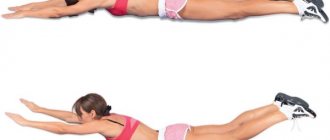08/16/2018 Category: During pregnancyAuthor: mila20012005
It would seem, well, what kind of sport can be done during pregnancy. It turns out that it is very, very diverse and also useful. Many types of physical activity are not contraindicated for pregnant women if everything goes well. You can do breathing exercises, walking, swimming, yoga, exercises with a fitball, gymnastics, and physical therapy. All these activities should be carried out only under the supervision of a doctor, so as not to harm yourself and the child.
- Therapeutic exercise during pregnancy
- Contraindications to exercise therapy
- Exercise therapy - step-by-step instructions for techniques
Physical therapy in the first trimester
- Classes with fitball in the 2nd trimester
- Exercises for exercise therapy in the 3rd trimester
- Special gymnastics complex
Bodymaster.ru recommends Training Plans:
During the first few weeks of pregnancy, the heart rate (HR) increases by 8 beats per minute, at 32 weeks - up to 20 beats per minute, oxygen consumption increases by 10-20%. In the 2nd or 3rd trimester, the maximum performance of a pregnant woman’s heart decreases by 20-25%.
Hormonal and metabolic changes
During pregnancy, changes occur in the levels of progesterone, relaxin and estrogen. Changes in these hormones cause the uterus as well as breast tissue to grow. There is also a decrease in smooth muscle tone. Hormonal changes cause the ligaments around the joints to soften. This is most noticeable in the lumbosacral and pelvic regions.
Hormonal changes usually cause nausea, vomiting and decreased appetite. This usually occurs during the first trimester of pregnancy. Due to metabolic changes, pregnant women should consume over 3000 kcal per day.
Changes in the musculoskeletal system
The average weight gain for women during pregnancy is 12 kg. Excess weight causes changes in posture. These in turn create muscle imbalances. The abdominal wall is stretched. The lumbar muscles of the spine shorten, and the upper back muscles become long and weak. The front muscles of the chest and shoulders become really tight. As the baby's head moves forward, muscle activity in the back of the cervix increases.
All this suggests that exercise for pregnant women can bring incomparable benefits and help the expectant mother get into shape faster after childbirth.
Warnings
Pregnant women should not perform squats because they may cause the placenta to separate from the uterus. Make sure you only use light weights. In addition, you should not perform sudden movements; pregnant women should do each exercise slowly and correctly. Remember to breathe while doing exercises to ensure your child gets enough oxygen. Drink plenty of water throughout the day, especially before and after exercise. Choose healthy foods and try to eat 4-5 small meals a day.
Exercise therapy - step-by-step instructions for techniques
It is most convenient to divide the entire period of classes into trimesters. For each stage, appropriate sets of exercises have been selected. When drawing up programs, the length of pregnancy and the functional state of the woman must be taken into account.
Physical therapy in the first trimester
During this period, the formation of the fetus occurs, so the load should be moderate. The complex at this time may consist of the following tasks (number of repetitions individually, but not less than 4 times):
- Hands on the belt, we walk in a half-squat in place.
- Standing, we join our palms in front of our chests and squeeze them.
- We take hold of the back of the chair and sit down shallowly, spreading our legs.
- Leaning on the back of the chair, we raise our leg, bent at the knee, and move it to the side.
- We stand on our toes, stretch and slowly lower ourselves.
- Lying on your back, bend your knees left and right.
- Standing on all fours, first raise one leg up, then the other.
Classes with fitball in the 2nd trimester
The fetus is actively growing in size, the stress on the mother’s body is increasing, which means it’s time to start strengthening the muscles of the back and lower back. Fitball exercises are good for this. A fitball is a special large ball, you can sit on it, lie down on it, you need to choose its size based on your height.
Fitball exercises in the 2nd trimester strengthen the muscles of the back and legs
Fitball exercises in the 2nd trimester include muscle stretching tasks:
- We sit on the ball and spread our arms to the sides. We roll from side to side, moving our pelvis over the ball.
- Sit on a chair and gently squeeze the ball between your legs.
- Standing with your feet shoulder-width apart, the ball is sandwiched between your back and the wall at waist level. We squat so that the ball rises to the shoulders.
- Lie on the floor, put your feet on a fitball, raise your pelvis to the same level as your whole body, fix the position, then slowly lower yourself back.
- Lie on the fitball with your back, relax your arms and legs, as if hanging.
- To relax, we kneel down, lean our chest on the ball and wrap our arms around it.
During pregnancy, exercise therapy was contraindicated for me, as there was a risk of miscarriage. But my friend studied in a group at the antenatal clinic for 9 months. There they were not only given therapeutic exercises, but also psychologically prepared for pregnancy and childbirth. She spoke especially well of exercises with a fitball: they relieve tension and train muscles. A swimming pool is an excellent addition to exercise therapy classes. Being in the water takes the pressure off your growing belly on your back and allows it to rest. My friend felt good throughout her pregnancy and was practically not tired.
Exercises for exercise therapy in the 3rd trimester
Therapeutic exercise is especially necessary in the last months of pregnancy; it helps prepare the body for childbirth. The intensity and volume of exercises during this period are minimal. Exercises are carried out mainly while sitting or lying down. During this period, the following complex is suitable:
- We start with a warm-up: walking in place, bending the body, turning, circular rotations of the head.
- Standing on all fours, we bend our back, then round it.
- Stand straight, hands clasped at the back of your head, elbows connected in front of your face. As you inhale, we move them apart, and as you exhale, we bring them together.
- While standing, place your hands on your waist. Bending your knees, we move your pelvis back and forth. At the same time, we compress the muscles of the vagina.
- Stand up, clasp your hands and raise them up, lower your hands.
- Get on all fours. As you inhale, slowly sit on your heels, exhaling, return to the starting position.
- Sit cross-legged with your soles of your feet together. Apply gentle pressure to your knees.
- Kneeling, step one leg out, come back, repeat with the other leg.
- Lying on your back, place your feet hip-width apart, lift your pelvis as you inhale, and lower as you exhale.
Therapeutic exercises in the 3rd trimester allow you to prepare for childbirth
Special gymnastics complex
For pregnancy pathologies, special complexes are also developed. This system has 4 stages. The duration of the stages depends on when you start training. The stage is 2 weeks if the course began at 32 weeks. If earlier, then the third and fourth stages are lengthened.
At the initial stage, training is carried out:
- proper breathing;
- discharge of individual muscle groups;
- performing simple gymnastic exercises.
At the second stage the following is worked out:
- gymnastic exercises with muscle tension and relaxation;
- movements for body coordination;
- coordination of breathing and muscle work.
At the third stage happens:
- Learning exercises to help the body take positions as during childbirth.
- Performing movements with tension of some muscles and simultaneous release of others.
- Learning the ability to tense individual muscles without straining the entire body.
At the final stage, the acquired motor skills are practiced and consolidated.
Read more about gymnastics for late pregnant women in our article - The tummy is not a hindrance: gymnastics in the third trimester of pregnancy.
An approximate set of exercises:
Introductory part
- Standing, arms along the body. Turns right, left 180°.
- We walk at a walking pace in place.
- Walking in place while simultaneously spreading your arms to the sides.
- Movement with arms spread to the sides and simultaneous turns to the right and left.
- A move with simultaneous understanding of the knee. Standing, hands behind your back with elbows clasped.
- Movement in a half-squat, feet shoulder-width apart, knees apart.
- Walking while waddling, transferring weight from one leg to the other.
Main part
- Standing in a circle. Feet shoulder-width apart, arms under the chest: spreading your arms to the sides, turning your body to the left (right) - inhale, returning to the starting position - exhale.
- Standing, feet shoulder-width apart, hands on your belt. “Pump” - tilt to the right, hands slide down the thigh, along the body - exhale, straighten - inhale.
- Standing in a circle, holding hands. Tilt the body back - inhale, tilt forward - exhale.
- Standing, hands on your belt. Feet shoulder-width apart, circular movements of the body for 4 counts.
- Stand in a circle, holding hands, legs wide apart. Bending the right leg at the knee (left straight), transferring the weight of the body to the right - exhale, returning to the I. p. - inhale.
- Stand in a circle, holding hands, feet shoulder-width apart. Springy squats with a gradual increase in amplitude. Squatting - exhale, straightening - inhale.
- Standing, alternately relaxing each leg - “shaking”.
Final part
- Walk at a walking pace, arms extended, squeeze the expander with one hand, relax the other hand. We change hands.
- Walking in a circle with the task of attention: on the second and fourth counts, clap your hands, on the third and fifth counts, stamp your foot.
- Walking at a walking pace with arms raised and lowered.
The duration of the exercises is individual. Preferably until severe muscle fatigue occurs.
If during exercise you feel weakness, nausea, dizziness or other unpleasant sensations, stop training immediately.
The benefits of exercise for pregnant women
Through prenatal exercises, expectant mothers can maintain or improve their cardiovascular health, as well as muscle strength and flexibility. They may also experience fewer prenatal discomforts such as constipation, swollen limbs, cramps, nausea, varicose veins, insomnia, fatigue, back pain and other orthopedic conditions.
Precautionary measures
It is recommended to refrain from any physical activity if:
- You have toxicosis accompanied by vomiting.
- The previous pregnancy ended in miscarriage.
- The uterus is in good shape.
- The placenta is too low.
- You are sick with something.
- After exercise, my stomach hurts.
Also, under no circumstances should you exercise for the purpose of losing weight. Physical exercise is needed only to maintain muscle tone and improve blood circulation, that’s all.
Bodymaster.ru recommends Fitness Trainers:
Women can improve their posture along with body biomechanics, increase energy levels and increase blood circulation. Exercising during pregnancy is beneficial, but women should maintain a lower resting heart rate.
With regular exercise, pregnant women experience a significant reduction in weight gain. The number of birth problems is significantly reduced: the risk of caesarean section is reduced by 75% and maternal exhaustion by 75%. There is a 50% reduction in the need to use oxytocin (which helps induce labor).
Studies have shown that with regular exercise, pregnant women experience a 30% reduction in active labor time. And after giving birth, fewer cases of postpartum depression occur during recovery.
Back
| № | Starting position, description | Number of repetitions |
| 1 | IP (starting position) knee-wrist support. Inhale—bend your back up as much as possible, exhale—bend your back down. The pace is slow. | 3-5 times |
| 2 | I.p. the same. Extend your right arm forward, left leg back. Raise them to a line parallel to the floor. Try to maintain balance and repeat on the other side. | 5-15 seconds on each side |
| 3 | I.p. the same. Without changing the position of your hands, move your pelvis back as much as possible and try to place it on your heels. The stomach should not be squeezed; it should fit freely between the knees. Reach your forehead towards the floor. | 15-60 seconds |
Physical education for pregnant women
The program includes light weight training along with cardio training. Work all major body parts except the abdominal muscles and lower back muscles. It may not be safe to train these two muscle groups during pregnancy.
The goal of training for pregnant women is not to gain weight, but to stay in shape, so use only light weights. Avoid heavy things, because in the end you can harm yourself and your child. Perform each pregnancy exercise in 3 sets of 15 repetitions. Rest periods should be fairly short - within 2-3 minutes.
Many pregnant women experience back pain, mainly because the 12-15 kg of weight gained during pregnancy is mostly distributed around the abdominal area.
This causes women's center of gravity to move forward, resulting in greater curvature in the lower spine. The solution to this problem lies in stretching. Light stretching should be done after warming up, especially if you want to prevent back pain.
Along with strength training, there is cardio training and this is a really great exercise for pregnant women. One of the best cardiovascular activities for a pregnant woman can be swimming. It will strengthen the heart and also improve the delivery of oxygen to the muscles.
Swimming is good for your shoulders and abdominal muscles, which can lower high blood pressure and improve joint mobility.
Swimming is one of the most enjoyable cardiovascular exercises, but when it comes to relaxation exercises for pregnant women, yoga still ranks number one. Yoga is very relaxing, and in general it is very useful for pregnant women. Yoga can help you prepare your mind and body for one of the most exciting times of pregnancy - labor and birth.
Contraindications for exercise during pregnancy
It is necessary to discuss physical activity and discuss a set of activities with a doctor if you have chronic diseases (heart, kidneys, lungs, etc.);
- Toxicosis of pregnant women, both early and late (preeclampsia), becomes a contraindication;
- You need to be careful with established polyhydramnios and pronounced uterine tone.
Any discomfort - dizziness, tachycardia, shortness of breath, weakness, pain in the lower abdomen, the appearance of vaginal discharge - is a reason to immediately stop exercising. If symptoms do not go away or become more intense, you should seek medical help.
Training frequency for pregnant women
Pregnant women should exercise 5 days a week, with 3 days of light weight training, 1 day of cardio, and 1 day of yoga. The training program we offer excludes weekends, so you can relax and spend time as you want. Every 2 or 3 months it is recommended to take a week off.
Note: Studies have shown that women who exercise 5 days a week give birth to lighter babies. The only reason they had lower birth weight was because they had less subcutaneous fat than others. After 5 years, these children were no different from those born at the same time to non-athletic mothers.
Also make sure you change up your pregnancy exercise program slightly every few weeks or months. Talk to your doctor as often as possible to make sure you are in good health. Keep a training diary and show it to your doctor to make sure you are doing the right thing.
Write down your training program and diet in a notebook. Include the times you arrived and left the gym and all exercises performed along with the number of sets and repetitions. In your diet plan, write down everything you eat, the number of meals, the number of calories, and the amount of fat, carbohydrates, and protein for each meal.
Do this daily and when you have your baby and look at all you have accomplished, you will be amazed and proud of your accomplishments!
What exercises should you not do during pregnancy?
The list of prohibited exercises:
- On the press, including crunches;
- Plank and push-ups;
- Jumping, stretching;
- Yoga with vacuum exercises.
In addition, you will have to forget for a while about traumatic sports - rollerblading, skating, cycling, wrestling, equestrianism.
Prenatal training for pregnant women
There is no one workout that suits everyone. Training should be individual for each pregnant woman. Women should train at a comfort level, which should be between 5 and 8 on the 10-level RTS (Subjective Perceived Tension) scale. Over time, you will need to exercise less to achieve the same level of RPE.
Training to the point of exhaustion should always be avoided. The duration of training should be determined by its intensity. Thus, if the intensity increases, the duration should decrease. Workouts consisting of cardio exercises for pregnant women should last no more than 45 minutes.
In the 3rd trimester, fetal nutrition and energy balance are very important. If you burn more calories during exercise, you need to consume more calories to help balance your energy levels. Eating actively in the 3rd trimester of pregnancy can be difficult as the stomach becomes smaller and there is a risk of heartburn.
It is important to respond quickly to any muscle imbalance caused by pregnancy. It can lead to discomfort, pain or even injury. The most important muscles to strengthen are the scapular contractile muscles, the abdominal muscles, and the pelvic diaphragm. The transverse abdominal muscles should first be trained in isolation and then integrated into other exercises for pregnant women.
A strong pelvic diaphragm will help improve control and rest during labor. These five layers of muscle and fascia attach to the pelvis. They support internal organs and affect the bladder, bowel and sexual function. Kegel exercises are a great way to strengthen your pelvic floor muscles.
Breast
| № | Starting position, description | Number of repetitions |
| 1 | Shallow push-ups from the floor in a knee-wrist position (on all fours). There is a straight line from the shoulders to the knees, the arms are wide. Inhale - down, exhale - straighten your arms. The lower back should not sag. | 2-10 times |
| 2 | Squeezing a rubber ball. Sitting or lying on your back. Elbows to the sides, hold the ball in your palms at chest level. As you exhale, squeeze the ball as much as possible. | 20-30 times |
The importance of breathing exercises
Doctors often differ in their opinions about the importance of breathing exercises for pregnant women, so we will present the less common one. According to obstetrician-gynecologist E. Berezovskaya (colleague and co-author of the famous doctor E. Komarovsky), the influence of breathing exercises for pregnant women in the 2-3 trimesters on the course and outcome of labor is somewhat exaggerated.
Breathing exercises cannot be rejected as a psychological (distractive) component in a childbirth preparation program. “But women who do breathing exercises and those who don’t give birth are the same,” since, according to the doctor, the birth pattern is inherited by every pregnant woman.
Breathing exercises











